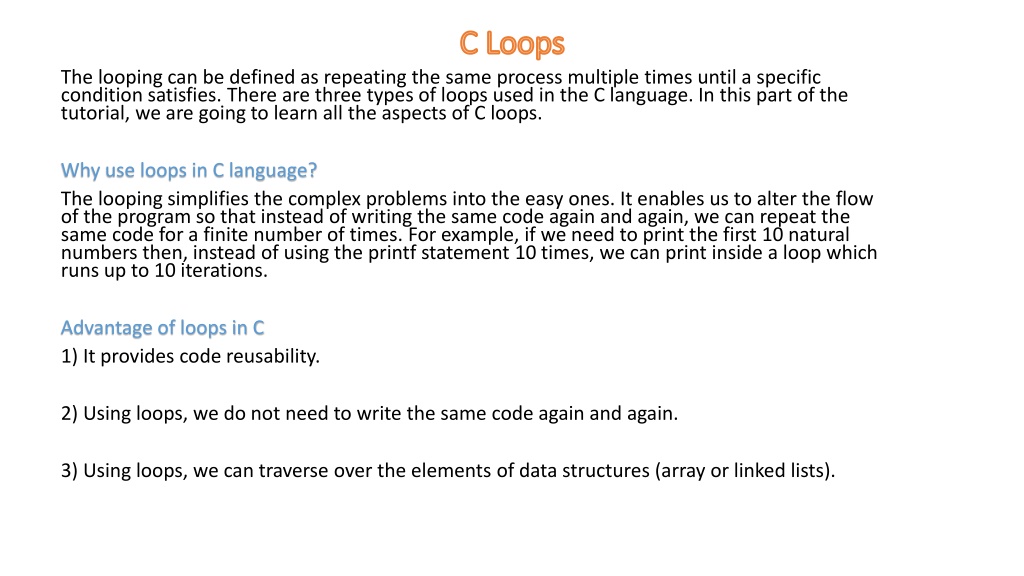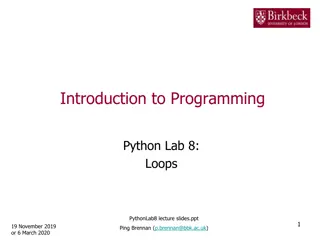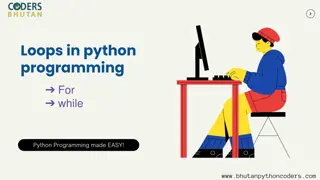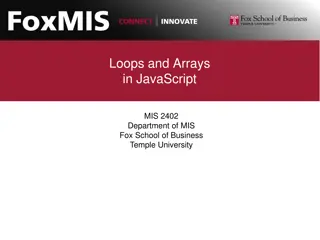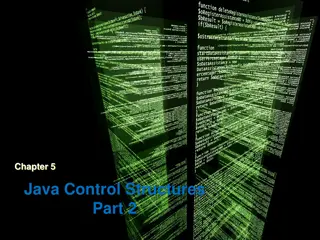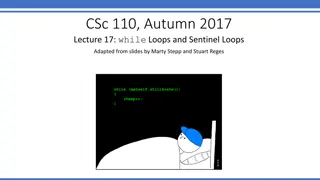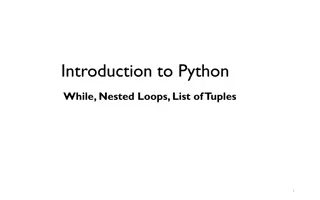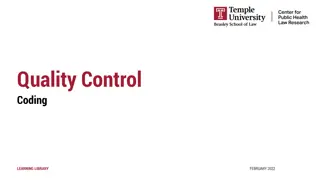C Language Loops for Efficient Coding
The tutorial delves into the three types of loops in C language - do-while, while, and for loops - and highlights their advantages in simplifying complex problems. Learn the syntax, examples, and properties of each loop to enhance your coding skills.
Download Presentation

Please find below an Image/Link to download the presentation.
The content on the website is provided AS IS for your information and personal use only. It may not be sold, licensed, or shared on other websites without obtaining consent from the author.If you encounter any issues during the download, it is possible that the publisher has removed the file from their server.
You are allowed to download the files provided on this website for personal or commercial use, subject to the condition that they are used lawfully. All files are the property of their respective owners.
The content on the website is provided AS IS for your information and personal use only. It may not be sold, licensed, or shared on other websites without obtaining consent from the author.
E N D
Presentation Transcript
C Loops C Loops The looping can be defined as repeating the same process multiple times until a specific condition satisfies. There are three types of loops used in the C language. In this part of the tutorial, we are going to learn all the aspects of C loops. Why use loops in C language? The looping simplifies the complex problems into the easy ones. It enables us to alter the flow of the program so that instead of writing the same code again and again, we can repeat the same code for a finite number of times. For example, if we need to print the first 10 natural numbers then, instead of using the printf statement 10 times, we can print inside a loop which runs up to 10 iterations. Advantage of loops in C 1) It provides code reusability. 2) Using loops, we do not need to write the same code again and again. 3) Using loops, we can traverse over the elements of data structures (array or linked lists).
Types of C Loops There are three types of loops in C language that is given below: do while while for do-while loop in C The do-while loop continues until a given condition satisfies. It is also called post tested loop. It is used when it is necessary to execute the loop at least once (mostly menu driven programs). The syntax of do-while loop in c language is given below: do{ //code to be executed }while(condition);
do while example There is given the simple program of c language do while loop where we are printing the table of 1. #include<stdio.h> int main(){ int i=1; do{ printf("%d \n",i); i++; }while(i<=10); return 0; }
while loop in C while loop in C While loop is also known as a pre-tested loop. In general, a while loop allows a part of the code to be executed multiple times depending upon a given boolean condition. It can be viewed as a repeating if statement. The while loop is mostly used in the case where the number of iterations is not known in advance. Syntax of while loop in C language The syntax of while loop in c language is given below: while(condition){ //code to be executed }
Example of the while loop in C language Let's see the simple program of while loop that prints table of 1. #include<stdio.h> int main() { int i=1; while(i<=10) { printf("%d \n",i); i++; } return 0; }
Properties of while loop Properties of while loop A conditional expression is used to check the condition. The statements defined inside the while loop will repeatedly execute until the given condition fails. The condition will be true if it returns 0. The condition will be false if it returns any non-zero number. In while loop, the condition expression is compulsory. Running a while loop without a body is possible. We can have more than one conditional expression in while loop. If the loop body contains only one statement, then the braces are optional.
Example 1 #include<stdio.h> void main () { int j = 1; while(j+=2,j<=10) { printf("%d ",j); } printf("%d",j); } Output 3 5 7 9 11
for loop in C for loop in C The for loop in C language is used to iterate the statements or a part of the program several times. It is frequently used to traverse the data structures like the array and linked list. Syntax of for loop in C The syntax of for loop in c language is given below: for(Expression 1; Expression 2; Expression 3){ //code to be executed }
C for loop Examples Let's see the simple program of for loop that prints table of 1. #include<stdio.h> int main() { int i=0; for(i=1;i<=10;i++) { printf("%d \n",i); } return 0; }
C Program: Print table for the given number using C for loop #include<stdio.h> int main(){ int i=1,number=0; printf("Enter a number: "); scanf("%d",&number); for(i=1;i<=10;i++){ printf("%d \n",(number*i)); } return 0; }
Nested Loops in C Nested Loops in C C supports nesting of loops in C. Nesting of loops is the feature in C that allows the looping of statements inside another loop. Let's observe an example of nesting loops in C. Any number of loops can be defined inside another loop, i.e., there is no restriction for defining any number of loops. The nesting level can be defined at n times. You can define any type of loop inside another loop; for example, you can define 'while' loop inside a 'for' loop. Syntax of Nested loop Outer_loop { Inner_loop { // inner loop statements. } // outer loop statements. }
Outer_loop and Inner_loop are the valid loops that can be a 'for' loop, 'while' loop or 'do- while' loop. Nested for loop The nested for loop means any type of loop which is defined inside the 'for' loop. for (initialization; condition; update) { for(initialization; condition; update) { // inner loop statements. } // outer loop statements. }
Example of nested for loop #include <stdio.h> int main() { int n;// variable declaration printf("Enter the value of n :"); // Displaying the n tables. for(int i=1;i<=n;i++) // outer loop { for(int j=1;j<=10;j++) // inner loop { printf("%d\t",(i*j)); // printing the value. } printf("\n"); }
Explanation of the above code First, the 'i' variable is initialized to 1 and then program control passes to the i<=n. The program control checks whether the condition 'i<=n' is true or not. If the condition is true, then the program control passes to the inner loop. The inner loop will get executed until the condition is true. After the execution of the inner loop, the control moves back to the update of the outer loop, i.e., i++. After incrementing the value of the loop counter, the condition is checked again, i.e., i<=n. If the condition is true, then the inner loop will be executed again. This process will continue until the condition of the outer loop is true.
